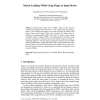Free Online Productivity Tools
i2Speak
i2Symbol
i2OCR
iTex2Img
iWeb2Print
iWeb2Shot
i2Type
iPdf2Split
iPdf2Merge
i2Bopomofo
i2Arabic
i2Style
i2Image
i2PDF
iLatex2Rtf
Sci2ools
APCHI
2008
IEEE
2008
IEEE
Muscle Loadings While Using Finger as Input Device
Finger-operated input device (FOID) might provide effective pointing and dragging control. However, it was suspected that the repetitive nature of the pointing and dragging tasks while operating the FOID would induce finger muscle fatigue. This study examined the finger strain by collecting electromyographic (EMG) data from 10 subjects while playing "computer solitaire" using the FOID or a trackball mouse for 40 minutes each. Pair-wise comparisons of electrical activity and median frequency showed no significant differences in these fatigue measurements between the new FOID and the trackball mouse. On the other hand, results of JASA indicted less finger muscle loading for the new FOID than that of the trackball. These results are of heuristic value and provide a promising basis for future development of the concept of FOIDs.
| Added | 12 Oct 2010 |
| Updated | 12 Oct 2010 |
| Type | Conference |
| Year | 2008 |
| Where | APCHI |
| Authors | Yung-Hui Lee, Wei-Yow Chen, Yi-Cherng Su |
Comments (0)

